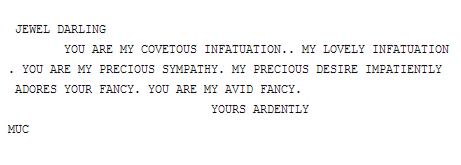| LoveLetters Wins Tony Sale Award |
| Written by Historian | |||
| Friday, 12 October 2012 | |||
|
The first Tony Sale Award has been won by Dr David Link for his computer art installation LoveLetters, a replica of a 1951 computer with reconstructed software that generates texts to express and arouse emotions. A new award to recognize outstanding achievements in computer conservation was initiated this year by the Computer Conservation Society with sponsorship from Google. It honors Tony Sale who led the team that rebuilt the Colossus computer. Four nominations were received for the inaugural award, the other three being the restoration of the DEC PDP 1 at the Computer History Museum in California, USA; the reconstruction and simulation of of Konrad Zuse's Z3 computer in Hunsfeld, Germany and the Time-Line Archive which collects, restores and exhibits early computers and electronics, based in West Cumbria, UK. The winning entry reconstructs both iconic hardware and software to produce an interactive multimedia computer art installation. In terms of hardware it is a replica of the 1951 Ferranti Mark 1, an industrial version of the Manchester Baby, a prototype of the first fully electronic universal computer controlled by software, which was built by a team of engineers at Manchester University, headed by Freddy Williams and in cooperation with Alan Turing and Max Newman. The automated love letters software was originally written In 1953-1954 by Christopher Strachey, one of the very first software developers, using the programming system devised by Alan Turing. It used the built-in random generator of the Ferranti Mark 1 to generate texts intend to express and arouse emotions and referred to as ‘love letters’.
Although the source code of the software survived in the Bodleian Library, Oxford, the functionality of the program was impossible even to guess at. To analyse it, meant resurrecting the original machine’s software and re-running the algorithm. Initially, in 2006 when David Link tried to execute the source code, a sub-routine was missing, and he coded the procedure to be integrated with the authentic files. Meanwhile the real routine was found and incorporated with the reconstructed software. This endeavour is also part of a larger project to safeguard the entire scientific Mark 1 software from 1948-1958. The art installation, which was first shown at the Centre for Art & Media Technology Karlsruhe in 2009 and has since been on display since at different centres in England and Germany, invites visitors to compose their names on the switches of the console using the five-bit Baudot code the machine was originally programmed in.
This allows them to "sign" the "loveletters" that are continuously generated and projected on a large screen. Once a day, at a randomly selected moment, the machine autonomously reads out loud a loveletter on the megaphones mounted on the outside wall of the exhibition venue and prints it on the reconstructed Creed 7 teleprinter from 1931. The exhibit also has a digital display of authentic documents. These include the lab notebook of one of the Mark 1's main constructors, Geoff Tootill, the maintenance engineers’ logbook from July 1951, all the manuals for the machine (Turing 1952, Prinz 1952) and several sets of photos. The archive of loveletter message generated by the replica machine can be seen on David Link's site together with the components of the exhibit. In making the award at at an event hosted by the British Computer Society in London on October 11, 2012, Rachel Burnett, who chaired the panel of judges and is Chair of the Computer Conservation Society, said: "The winning entry by Dr David Link is both a brilliant technical construction and a work of art. Its fusion of art, engineering and history celebrates one of the first artistic applications of the computer in a visually attractive way. The wide cultural appeal, originality and touch of genius of this entry set it apart for us and has given us an inspiring first winner of the Tony Sale Award."
More InformationDavid Link's webite: LoveLetters_1.0 Related ArticlesAward Established for Computer Conservation
Comments
or email your comment to: comments@i-programmer.info
To be informed about new articles on I Programmer, install the I Programmer Toolbar, subscribe to the RSS feed, follow us on, Twitter, Facebook, Google+ or Linkedin, or sign up for our weekly newsletter.
|
|||
| Last Updated ( Friday, 12 October 2012 ) |




